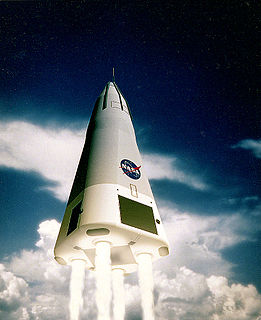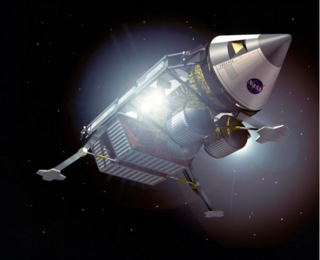Related Research Articles

The Surveyor program was a NASA program that, from June 1966 through January 1968, sent seven robotic spacecraft to the surface of the Moon. Its primary goal was to demonstrate the feasibility of soft landings on the Moon. The Surveyor craft were the first American spacecraft to achieve soft landing on an extraterrestrial body. The missions called for the craft to travel directly to the Moon on an impact trajectory, a journey that lasted 63 to 65 hours, and ended with a deceleration of just over three minutes to a soft landing. The program was implemented by NASA's Jet Propulsion Laboratory (JPL) to prepare for the Apollo program. JPL selected Hughes Aircraft to develop the spacecraft system. The total cost of the Surveyor program was officially $469 million.

The Apollo Lunar Module, or simply Lunar Module, originally designated the Lunar Excursion Module (LEM), was the lander spacecraft that was flown from lunar orbit to the Moon's surface during the U.S. Apollo program. It was the first crewed spacecraft to operate exclusively in the airless vacuum of space, and remains the only crewed vehicle to land anywhere beyond Earth.

The S-IVB was the third stage on the Saturn V and second stage on the Saturn IB launch vehicles. Built by the Douglas Aircraft Company, it had one J-2 rocket engine. For lunar missions it was fired twice: first for Earth orbit insertion after second stage cutoff, and then for translunar injection (TLI).

The Constellation Program is a cancelled crewed spaceflight program developed by NASA, the space agency of the United States, from 2005 to 2009. The major goals of the program were "completion of the International Space Station" and a "return to the Moon no later than 2020" with a crewed flight to the planet Mars as the ultimate goal. The program's logo reflected the three stages of the program: the Earth (ISS), the Moon, and finally Mars—while the Mars goal also found expression in the name given to the program's booster rockets: Ares. The technological aims of the program included the regaining of significant astronaut experience beyond low Earth orbit and the development of technologies necessary to enable sustained human presence on other planetary bodies.

The DC-X, short for Delta Clipper or Delta Clipper Experimental, was an uncrewed prototype of a reusable single-stage-to-orbit launch vehicle built by McDonnell Douglas in conjunction with the United States Department of Defense's Strategic Defense Initiative Organization (SDIO) from 1991 to 1993. Starting 1994 until 1995, testing continued through funding of the US civil space agency NASA. In 1996, the DC-X technology was completely transferred to NASA, which upgraded the design for improved performance to create the DC-XA.

The Bell Aerosystems Lunar Landing Research Vehicle was a Project Apollo era program to build a simulator for the Moon landings. The LLRVs were used by the FRC, now known as the NASA Armstrong Flight Research Center, at Edwards Air Force Base, California, to study and analyze piloting techniques needed to fly and land the Apollo Lunar Module in the Moon's low gravity environment.

A space rendezvous is a set of orbital maneuvers during which two spacecraft, one of which is often a space station, arrive at the same orbit and approach to a very close distance. Rendezvous requires a precise match of the orbital velocities and position vectors of the two spacecraft, allowing them to remain at a constant distance through orbital station-keeping. Rendezvous may or may not be followed by docking or berthing, procedures which bring the spacecraft into physical contact and create a link between them.

A retrorocket is a rocket engine providing thrust opposing the motion of a vehicle, thereby causing it to decelerate. They have mostly been used in spacecraft, with more limited use in short-runway aircraft landing. New uses are emerging since 2010 for retro-thrust rockets in reusable launch systems.
The Soviet crewed lunar programs were a series of programs pursued by the Soviet Union to land humans on the Moon, in competition with the United States Apollo program to achieve the same goal set publicly by President John F. Kennedy on 25 May 1961. The Soviet government publicly denied participating in such a competition, but secretly pursued two programs in the 1960s: crewed lunar flyby missions using Soyuz 7K-L1 (Zond) spacecraft launched with the Proton-K rocket, and a crewed lunar landing using Soyuz 7K-LOK and LK spacecraft launched with the N1 rocket. Following the dual American successes of the first crewed lunar orbit on 24-25 December 1968 and the first Moon landing on July 20, 1969, and a series of catastrophic N1 failures, both Soviet programs were eventually brought to an end. The Proton-based Zond program was canceled in 1970, and the N1-L3 program was de facto terminated in 1974 and officially canceled in 1976. Details of both Soviet programs were kept secret until 1990 when the government allowed them to be published under the policy of glasnost.

A Moon landing is the arrival of a spacecraft on the surface of the Moon. This includes both crewed and robotic missions. The first human-made object to touch the Moon was the Soviet Union's Luna 2, on 13 September 1959.
Micro-Space was an aerospace corporation based in Denver, Colorado, founded in February 1977 by Richard P. Speck under the name Spectron Instrument Corporation. The corporation changed its name to "Micro-Space, Inc." in 1998. It was dissolved in 2011, following the death of the founder.

Masten Space Systems is an aerospace manufacturer startup company in Mojave, California that is developing a line of vertical takeoff, vertical landing (VTVL) rockets, initially for uncrewed research sub-orbital spaceflights and eventually intended to support robotic orbital spaceflight launches.

Orel or Oryol, formerly Federation, and PPTS, is a project by Roscosmos to develop a new-generation, partially reusable crewed spacecraft.
Moon Express is an American privately held early-stage company formed by a group of Silicon Valley and space entrepreneurs. It had the goal of winning the $30 million Google Lunar X Prize, and of ultimately mining the Moon for natural resources of economic value. The company was not able to make a launch attempt to reach the Moon by March 31, 2018, the deadline for the prize. As of February 2020, Moon Express is focused on supporting NASA under its Commercial Lunar Payload Services (CLPS) contract.

SpaceIL is an Israeli organization, established in 2011, that was competing in the Google Lunar X Prize (GLXP) contest to land a spacecraft on the Moon. SpaceIL successfully launched its Beresheet lander on 22 February 2019 at 01:45 UTC; it entered lunar orbit on 4 April 2019 at 14:18 UTC. On 11 April 2019, during the landing procedure, a problem occurred in the final minutes of flight. Communications were lost with the spacecraft, long enough for the braking process to fail, and the vehicle crashed on the lunar surface. The Beresheet mission had included plans to measure the Moon's magnetic field at the landing site, and was carrying a laser retroreflector, and a "time capsule" containing analog and digital information, created by the Arch Mission Foundation. Beresheet was the first Israeli spacecraft to travel beyond Earth's orbit and was the first privately funded landing on the Moon. Though the spacecraft crashed, Israel became the seventh country to make lunar orbit and the fourth country, after the Soviet Union, the United States, and China to attempt a soft landing on the Moon.

Blue Moon is a robotic space cargo carrier and lander for making cargo deliveries to the Moon. Designed and operated by Blue Origin for use on a mission aimed for 2024, Blue Moon derives from the vertical landing technology used in Blue Origin's New Shepard sub-orbital rocket.

The SpaceX Starship system is a fully-reusable, two-stage-to-orbit, super heavy-lift launch vehicle under development by SpaceX since 2012, as a self-funded private spaceflight project.

The Artemis program is a US government-funded crewed spaceflight program that has the goal of landing "the first woman and the next man" on the Moon, specifically at the lunar south pole region by 2024. The program is carried out predominantly by NASA, U.S. commercial spaceflight companies contracted by NASA, and international partners such as the European Space Agency (ESA), the Japan Aerospace Exploration Agency (JAXA), Canadian Space Agency (CSA), the Italian Space Agency (ASI) and the Australian Space Agency (ASA). NASA is leading the program, but expects international partnerships to play a key role in advancing Artemis as the next step towards the long-term goal of establishing a sustainable presence on the Moon, laying the foundation for private companies to build a lunar economy, and eventually sending humans to Mars.

The International Lunar Resources Exploration Concept (ILREC) was a proposed mission architecture under President George H. W. Bush's Space Exploration Initiative (SEI) by Kent Joosten, an engineer at Johnson Space Center. The plan would have used the help of international partners, mainly the Soviet Union, to assemble a lunar base and sustainable lunar transportation service.
References
- ↑ "Program Management". Lunar Lion. Retrieved May 2, 2018.
- ↑ "Lunar Lion team leader gives mission update to trustees". Penn State News. Retrieved November 25, 2013.
- ↑ http://news.psu.edu/story/367698/2015/08/31/academics/penn-state-lunar-lion-keeps-eyes-moon
- 1 2 Cappelli, Kathy. "Lunar lions complete first phase of rocket testing". The Daily Collegian . Retrieved November 25, 2013.
https://web.archive.org/web/20150926024402/http://lunarlion.psu.edu/puma-2-0-takes-shape/